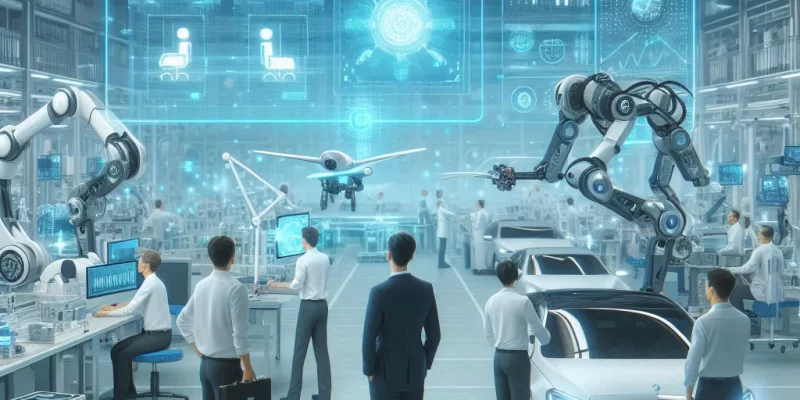

Industrial automation is evolving rapidly, and 2024 is set to be a landmark year for the industry. With advances in technology and shifts in market demands, manufacturers, engineers, and technologists need to stay ahead of the curve. This blog post will explore the future of industrial automation, offering insights and practical tips to help you prepare for what lies ahead.
The Rise of Autonomous Robots
Autonomous robots are more than just a trend; they’re the future of manufacturing. These robots can perform tasks without human intervention, making them invaluable in factories.
Benefits of Autonomous Robots
Autonomous robots can operate 24/7, increasing productivity. They also reduce human error, ensuring consistent quality. Finally, they can handle dangerous tasks, improving workplace safety.
Real-World Applications
Companies like Amazon use autonomous robots in their warehouses. These robots move products efficiently, reducing the time it takes to fulfill orders. Additionally, automotive manufacturers use them for precision tasks such as welding and assembly.
The Cost Factor
Though expensive initially, autonomous robots offer long-term savings. Reduced labor costs and increased productivity make them a worthwhile investment for many manufacturers.
Artificial Intelligence and Machine Learning
AI and machine learning are revolutionizing industrial automation. These technologies enable machines to learn from data, making smarter decisions over time.
Predictive Maintenance
One of the most significant advantages is predictive maintenance. AI algorithms analyze machine data to predict when a machine will fail. This allows for timely maintenance, preventing costly downtime.
Quality Control
AI-powered systems can detect defects that are invisible to the human eye. This ensures higher quality products and reduces waste. Companies like Siemens are already implementing these systems with great success.
Customization and Flexibility
AI allows manufacturers to customize products without reconfiguring entire production lines. This flexibility is crucial in today’s market, where consumer preferences change rapidly.
Internet of Things (IoT)
The IoT connects machines, sensors, and computers, enabling seamless communication. This interconnectedness is driving efficiency and innovation in industrial automation.
Smart Factories
In smart factories, IoT devices collect and analyze data in real-time. This data helps optimize production processes, reducing waste and improving efficiency.
Remote Monitoring
IoT enables remote monitoring of machinery. Technicians can diagnose issues from anywhere, speeding up repairs and minimizing downtime.
Energy Management
IoT systems can monitor energy use and identify inefficiencies. This allows manufacturers to reduce energy consumption, lowering costs and environmental impact.
Advanced Robotics
Robotics technology is advancing at a breakneck pace. New robots are more versatile and capable than ever before.
Collaborative Robots (Cobots)
Cobots work alongside humans, enhancing productivity. They are designed to be safe, with sensors that stop the robot if a human comes too close. This makes them ideal for tasks that require both human skill and robotic precision.
Precision and Speed
Advanced robotics offer unparalleled precision and speed. They can perform tasks faster and more accurately than humans, making them invaluable in high-volume production environments.
Versatility
Modern robots can be reprogrammed to perform different tasks. This versatility allows manufacturers to adapt quickly to changing market demands.
Blockchain Technology
Blockchain is not just for cryptocurrencies. It has significant applications in industrial automation.
Supply Chain Transparency
Blockchain provides a transparent and immutable record of transactions. This transparency is crucial for supply chain management, ensuring that all parts are genuine and sourced ethically.
Smart Contracts
Smart contracts automate transactions between machines. For example, a machine can order supplies automatically when it detects that stock levels are low. This reduces the need for human intervention and speeds up the supply chain.
Security
Blockchain technology enhances security by providing a tamper-proof record of transactions. This is particularly important in industries where data integrity is crucial.
Digital Twins
Digital twins are virtual replicas of physical assets. They allow manufacturers to simulate and optimize processes before implementing them in the real world.
Process Optimization
Digital twins enable manufacturers to test different scenarios and identify the most efficient processes. This reduces the risk of costly mistakes and improves overall efficiency.
Real-Time Monitoring
Digital twins provide real-time data on machine performance. This allows for immediate adjustments, ensuring optimal operation at all times.
Predictive Analytics
Digital twins use predictive analytics to foresee potential issues. This enables proactive maintenance, reducing downtime and extending the life of machines.
Cyber-Physical Systems
Cyber-physical systems integrate computer algorithms with physical processes. They are the backbone of Industry 4.0 and are essential for advanced manufacturing.
Integration with IoT
Cyber-physical systems work seamlessly with IoT devices. This integration enables real-time data collection and analysis, driving efficiency and innovation.
Enhanced Control
These systems provide enhanced control over manufacturing processes. They can make real-time adjustments to optimize performance and ensure product quality.
Increased Collaboration
Cyber-physical systems facilitate collaboration between machines and humans. This collaboration enhances productivity and allows for more complex manufacturing processes.
Cloud Computing
Cloud computing is transforming industrial automation. It provides scalable resources and storage, enabling manufacturers to handle large volumes of data.
Data Storage
The cloud offers virtually unlimited data storage. This is crucial for storing the vast amounts of data generated by modern manufacturing processes.
Scalability
Cloud computing allows manufacturers to scale resources up or down based on demand. This flexibility ensures that they can handle peak production periods without investing in expensive hardware.
Accessibility
Cloud-based systems can be accessed from anywhere. This enables remote monitoring and management, improving efficiency and reducing the need for on-site staff.
Augmented Reality (AR)
AR is making waves in industrial automation. It overlays digital information onto the real world, providing valuable insights and enhancing productivity.
Maintenance and Training
AR can assist with machine maintenance by providing technicians with real-time information and instructions. It also enhances training by providing immersive, hands-on experiences.
Enhanced Visualization
AR provides enhanced visualization of complex systems. This makes it easier for engineers to understand and troubleshoot issues.
Remote Assistance
AR enables remote assistance by allowing experts to see what technicians see and provide real-time guidance. This speeds up repairs and reduces downtime.
Edge Computing
Edge computing processes data closer to where it’s generated. This reduces latency and improves efficiency.
Real-Time Processing
Edge computing enables real-time data processing. This is crucial for applications that require immediate action, such as predictive maintenance and quality control.
Reduced Bandwidth
By processing data locally, edge computing reduces the need for bandwidth. This lowers costs and improves performance, especially in remote locations.
Enhanced Security
Edge computing enhances security by keeping data local. This reduces the risk of data breaches and ensures compliance with data protection regulations.
3D Printing
3D printing is revolutionizing manufacturing. It allows for the rapid production of complex parts and prototypes.
Customization
3D printing enables the customization of products without the need for retooling. This allows manufacturers to meet specific customer needs quickly and efficiently.
Rapid Prototyping
3D printing speeds up the prototyping process. This enables faster product development and reduces time to market.
Cost-Effective Production
3D printing reduces waste and lowers production costs. It is particularly cost-effective for small production runs and complex parts.
Big Data Analytics
Big data analytics is transforming how manufacturers operate. It provides valuable insights that drive efficiency and innovation.
Process Optimization
Big data analytics enables manufacturers to identify inefficiencies and optimize processes. This reduces waste and improves overall productivity.
Predictive Maintenance
Big data analytics enhances predictive maintenance by analyzing vast amounts of machine data. This enables timely maintenance and reduces downtime.
Customer Insights
Big data analytics provides valuable insights into customer behavior. This enables manufacturers to tailor products and services to meet customer needs.
Sustainable Manufacturing
Sustainability is becoming increasingly important in industrial automation. Manufacturers are adopting green technologies to reduce their environmental impact.
Energy Efficiency
Manufacturers are using energy-efficient machines and processes to reduce energy consumption. This lowers costs and reduces their carbon footprint.
Waste Reduction
Sustainable manufacturing focuses on reducing waste. This includes recycling materials and using more efficient production processes.
Eco-Friendly Materials
Manufacturers are increasingly using eco-friendly materials. This includes biodegradable plastics and sustainably sourced raw materials.
Workforce Training
The rise of industrial automation requires a skilled workforce. Manufacturers are investing in training programs to ensure their employees have the necessary skills.
Upskilling Programs
Manufacturers are offering upskilling programs to help employees adapt to new technologies. This ensures that they can operate and maintain advanced machinery.
Apprenticeships
Apprenticeship programs provide hands-on training for new employees. This ensures that they have the skills needed to succeed in a modern manufacturing environment.
Continuous Learning
Manufacturers are promoting a culture of continuous learning. This encourages employees to stay updated with the latest technologies and best practices.
Regulatory Compliance
Regulatory compliance is crucial in industrial automation. Manufacturers must ensure that their processes and products meet regulatory standards.
Safety Standards
Manufacturers must adhere to safety standards to protect their employees. This includes regular inspections and maintenance of machinery.
Environmental Regulations
Manufacturers must comply with environmental regulations. This includes reducing emissions and managing waste responsibly.
Data Protection
Manufacturers must ensure that their data is secure and compliant with data protection regulations. This includes implementing robust security measures and regular audits.
Cybersecurity
Cybersecurity is a growing concern in industrial automation. Manufacturers must protect their systems from cyber threats.
Vulnerability Assessments
Manufacturers must conduct regular vulnerability assessments. This identifies potential weaknesses and enables them to implement necessary security measures.
Firewalls and Encryption
Manufacturers must use firewalls and encryption to protect their data. This prevents unauthorized access and ensures data integrity.
Employee Training
Cybersecurity training for employees is crucial. This ensures that they are aware of potential threats and know how to respond to them.
Conclusion
Industrial automation is evolving rapidly, and 2024 promises to bring exciting advancements. By staying ahead of these trends, manufacturers can improve efficiency, reduce costs, and gain a competitive edge. Whether it’s adopting autonomous robots, leveraging AI and IoT, or exploring new technologies like blockchain and digital twins, the future of industrial automation is bright.
For those keen to explore these advancements further, take the next step by integrating these technologies into your operations. The rewards will be well worth the effort.







